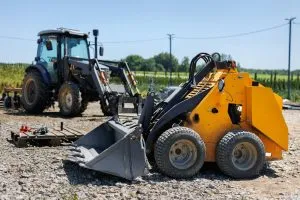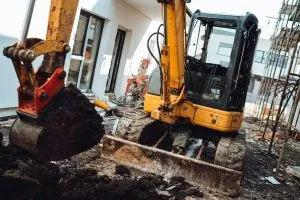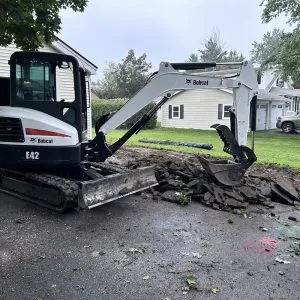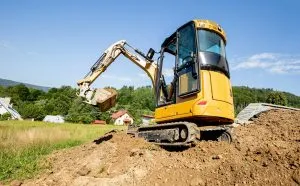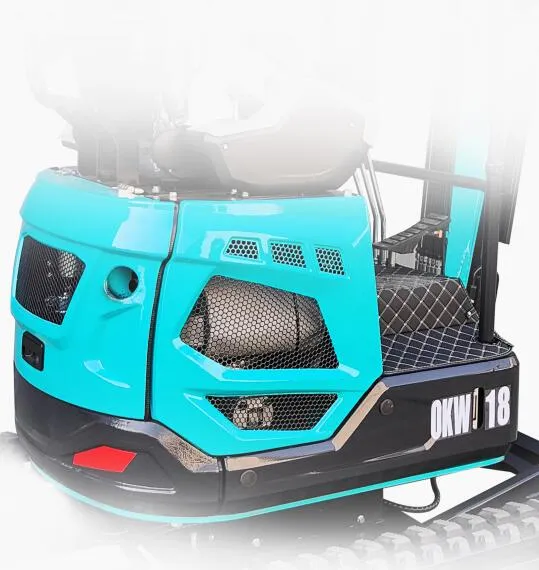When embarking on any construction or excavation project, choosing the right equipment is vital for success. Two of the most common and versatile pieces of heavy machinery you’ll encounter are backhoes and excavators. Both are powerful, efficient machines capable of digging, lifting, and moving materials. However, they have distinct features that make each more suitable for certain tasks.
In this guide, we’ll dive into the differences between backhoes and excavators, their specific functions, and how to determine which is the best choice for your project. Let’s start by exploring the fundamental aspects of these machines to help you make an informed decision.
1. What Is a Backhoe?
A backhoe is a versatile piece of machinery that features a two-part design with an arm and bucket attached to the rear and a loader on the front. The arm and bucket are used for digging and excavation, while the loader can be employed for moving soil or materials. This dual functionality makes backhoes suitable for a wide range of jobs, especially in smaller construction projects.
Backhoes are often mounted on a tractor-like base, giving them mobility and ease of use on various terrains. One of the key features of a backhoe is its ability to quickly switch between digging and loading tasks without requiring additional machinery.

2. What Is an Excavator?
Excavators are designed with a more specialized focus compared to backhoes. These machines consist of a rotating platform (called a “house”), an arm, a boom, and a bucket. They excel in tasks that require extensive digging, demolition, and lifting. Unlike backhoes, excavators are typically mounted on either tracks or wheels, with tracks offering superior stability on uneven surfaces.
Due to their robust design and larger size, excavators are better suited for large-scale construction or excavation jobs where heavy-duty digging or material moving is required.
3. Key Differences Between a Backhoe and an Excavator
While backhoes and excavators may seem similar, they differ in terms of design, functionality, and the types of projects they excel at.
- Size and Mobility: Backhoes are generally smaller than excavators and more mobile, making them better suited for smaller projects and tighter spaces. Excavators, on the other hand, are larger, heavier, and better suited for large-scale jobs.
- Versatility: A backhoe offers more versatility since it can switch between using the front loader and the rear digging arm. Excavators, however, are more specialized in digging and demolition tasks.
- Rotation and Range of Motion: Excavators have a full 360-degree rotating platform, which allows them to work in more dynamic positions. Backhoes typically have a limited range of motion, usually about 200 degrees.
- Attachments: Both machines support a range of attachments, but backhoes tend to have more varied options, including hammers, rippers, and snowplows. Excavators typically use attachments such as grapples, augers, and shears.
4. Advantages of Using a Backhoe
Backhoes are widely recognized for their flexibility and adaptability. Here are some specific advantages of using a backhoe:
- Dual Functionality: The ability to use both the back bucket and front loader makes backhoes highly efficient for jobs that require different functions, such as digging trenches and moving materials in one go.
- Smaller Size: Backhoes are often compact and can navigate tighter spaces, making them ideal for urban construction projects or sites with limited access.
- Cost Efficiency: Due to their smaller size and dual-functionality, backhoes tend to be more affordable both in terms of purchase price and operating costs. They are especially suitable for contractors working on smaller budgets.
- Attachments: Backhoes can be equipped with a wide range of attachments, increasing their utility for various applications. Some common attachments include hammers, augers, and grapples, making backhoes a one-machine solution for many tasks.

5. Advantages of Using an Excavator
While backhoes are versatile, excavators shine in large-scale, heavy-duty jobs that require specialized digging and lifting. Here are the main advantages of using an excavator:
- Heavy-Duty Performance: Excavators are built for power and precision, making them suitable for extensive digging, demolition, and material moving. Their size and strength allow them to tackle large-scale projects with ease.
- 360-Degree Rotation: The full 360-degree rotation of an excavator provides unmatched maneuverability, which is crucial for jobs where flexibility in movement is important, such as on uneven ground or in hard-to-reach locations.
- Track Stability: Many excavators are mounted on tracks, which offer superior stability on uneven or soft surfaces. This makes them highly effective in challenging environments such as muddy or hilly terrain.
- Greater Depth and Reach: Excavators have longer arms and can dig deeper than backhoes, which makes them ideal for projects requiring deep trenching or heavy-duty excavation.

6. Choosing Between a Backhoe and an Excavator: Key Considerations
When choosing between a backhoe and an excavator, you’ll need to consider several factors to determine which machine is the right fit for your project:
- Project Size and Scope: For large-scale projects that require extensive digging, demolition, or earthmoving, an excavator is often the better choice. For smaller projects that require versatility and mobility, a backhoe may be more practical.
- Site Conditions: If your work site has limited space or requires a machine that can easily move between different areas, a backhoe’s smaller size and mobility will be beneficial. On the other hand, if you’re working on uneven or challenging terrain, an excavator’s tracks and stability will provide better performance.
- Depth and Reach Requirements: If your project requires deep trenching or excavation at significant depths, an excavator will have the reach and power to meet those needs. A backhoe’s digging capabilities, while sufficient for many projects, are more limited in depth.
- Maneuverability and Rotation: If you need a machine that can rotate fully and operate in dynamic positions, an excavator’s 360-degree rotating platform is a major advantage. Backhoes have a more limited range of motion, typically around 200 degrees.
- Budget: Excavators are typically more expensive to rent or buy than backhoes. If your project is on a tighter budget and doesn’t require heavy-duty digging, a backhoe may be the more cost-effective option.
7. Common Applications for Backhoes
Backhoes are often used in the following scenarios:
- Small- to Medium-Sized Construction Projects: Because backhoes are smaller and more affordable, they are a common choice for residential construction or smaller commercial projects.
- Agriculture: Backhoes are frequently used in farming and agriculture for tasks like digging irrigation ditches, moving soil, or transporting equipment and materials.
- Landscaping: Backhoes are ideal for landscaping tasks, such as digging out tree roots, clearing land, or moving large quantities of soil and rocks.
- Road Maintenance: Their versatility makes backhoes useful for road repair and maintenance tasks, such as digging out damaged sections or clearing debris from roadways.

8. Common Applications for Excavators
Excavators, due to their heavy-duty design and capabilities, are best suited for larger and more demanding projects, such as:
- Large-Scale Excavation: Excavators are a go-to choice for large construction projects that require extensive earthmoving, digging, and material handling, such as foundation digging or site preparation.
- Demolition: The power and precision of excavators make them highly effective in demolition tasks, where precise control over material removal is critical.
- Mining: Excavators are commonly used in mining operations for digging out mineral deposits and removing overburden material.
- Heavy-Duty Landscaping: Excavators are suitable for large landscaping projects that require significant amounts of digging and material handling, such as pond excavation or land grading.
9. Rental vs. Purchase: What to Consider
Another important factor when deciding between a backhoe and an excavator is whether you plan to rent or buy the equipment. Here are some considerations for both options:
- Renting: Renting a backhoe or excavator is often the more cost-effective option for short-term projects. Renting allows you to access the right equipment without the long-term financial commitment of ownership.
- Buying: If you regularly undertake large projects or foresee long-term use of the equipment, purchasing may be more economical in the long run. Consider the purchase price, maintenance costs, and the expected lifespan of the machine when making your decision.

10. Fuel Efficiency and Environmental Impact
Fuel efficiency can play a significant role in your decision. While backhoes are typically more fuel-efficient due to their smaller size and lower power demands, excavators consume more fuel because of their greater engine power and larger size. However, some modern excavators are designed with fuel-efficient engines and lower emissions, which can help mitigate their environmental impact.
When it comes to environmental considerations, both types of equipment can be equipped with advanced emissions control systems that reduce their carbon footprint.
Conclusion: Making the Right Choice for Your Project
Choosing between a backhoe and an excavator ultimately comes down to the specific needs of your project. For smaller jobs requiring versatility and quick transitions between tasks, a backhoe is the ideal option. However, if your project demands heavy-duty excavation, demolition, or deep digging, an excavator’s power and capabilities make it the better choice.
By carefully considering factors such as project size, terrain, budget, and the specific tasks involved, you’ll be able to select the right machine for the job, ensuring efficiency, cost-effectiveness, and success in your construction or excavation endeavors.


